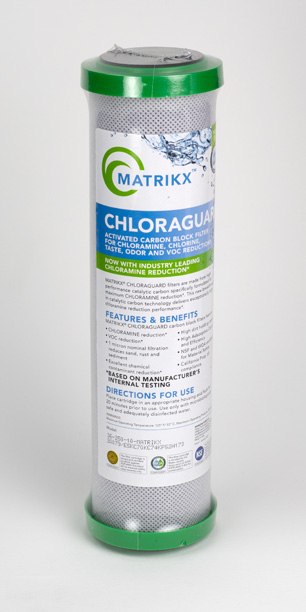How Often Should Carbon Filter Cartridges Be Changed?
MatriKX Chloraguard Filter Cartridge, 2.5″ X 9.75″ — Standard Drinking Water Size
The simple and probably the best answer for residential applications is that carbon filter cartridges should be changed at least once a year. The more complicated answer is that it all depends on what you expect of the cartridge, how much you know about your water, and how willing you are to monitor such things as the amount of water used and the flow rate.
Carbon filters are a very versatile tool that can be applied to many different problems. What they do best and easiest is remove chlorine and improve taste and odor. But they are also the most practical treatment for many more difficult problems, like chemicals in general (see how many times carbon appears as the treatment of choice in this contaminant removal chart), and very hard to treat items like VOCs and PFAS.
Below is the manufacturer’s lifespan recommendation for the high quality coconut shell carbon block filter pictured above.
- Chlorine: 45,000 @ 1 gpm,
- Chloramine: 4,000 @ 0.5 gpm,
- PFAS: 3,500 @ 0.5 gpm,
- VOC: 750 @ 0.5 gpm,
Note that if your requirement is only the removal of chlorine from drinking water the cartridge should last until you die of old age. However, if your city uses chloramine rather than chlorine as its disinfectant, it will last only about 1/10 as long, and you’ll have to be sure to run the water half as fast. Running the cartridge at “chlorine speed” will greatly reduce its service life as well as its effectiveness when treating chloramine or difficult contaminants like PFAS and VOCs.
In most cases the once-a year-rule works well and assures excellent performance with most contaminants. If more than a couple of people are using the water and VOCs are a known issue, changing the cartridge twice a year is a good idea.
And then, of course, there are variables to be considered like multi-cartridge filters, position of the cartridge within the unit (a reverse osmosis pre-filter treats much more and much dirtier water than a reverse osmosis post filter), water temperature, pH, etc. But, for simplicity, the once-a-year cartridge change works pretty well.





